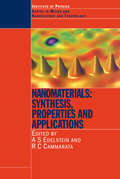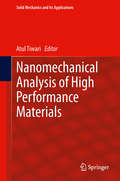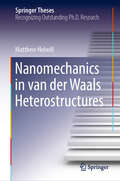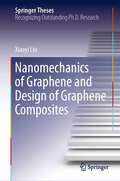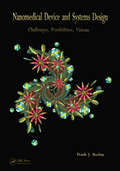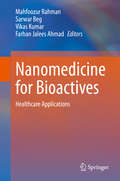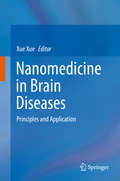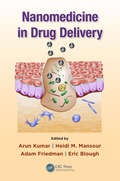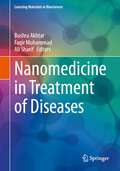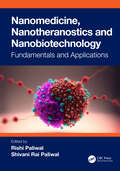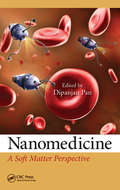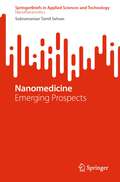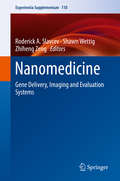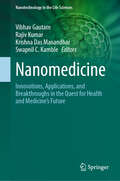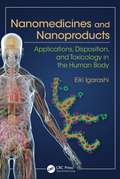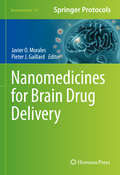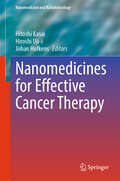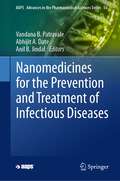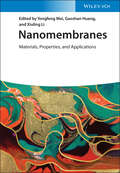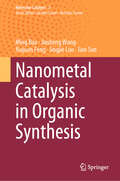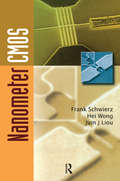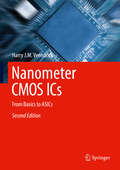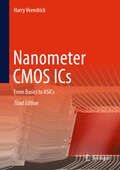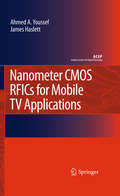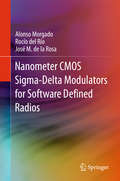- Table View
- List View
Nanomaterials: Synthesis, Properties and Applications, Second Edition
by A S Edelstein R C CammarataNanomaterials: Synthesis, Properties and Applications provides a comprehensive introduction to nanomaterials, from how to make them to example properties, processing techniques, and applications. Contributions by leading international researchers and teachers in academic, government, and industrial institutions in nanomaterials provide an accessibl
Nanomechanical Analysis of High Performance Materials
by Atul TiwariThis book is intended for researchers who are interested in investigating the nanomechanical properties of materials using advanced instrumentation techniques. The chapters of the book are written in an easy-to-follow format, just like solved examples. The book comprehensively covers a broad range of materials such as polymers, ceramics, hybrids, biomaterials, metal oxides, nanoparticles, minerals, carbon nanotubes and welded joints. Each chapter describes the application of techniques on the selected material and also mentions the methodology adopted for the extraction of information from the raw data. This is a unique book in which both equipment manufacturers and equipment users have contributed chapters. Novices will learn the techniques directly from the inventors and senior researchers will gain in-depth information on the new technologies that are suitable for advanced analysis. On one hand, fundamental concepts that are needed to understand the nanomechanical behavior of materials is included in the introductory part of the book. On the other, dedicated chapters describe the utilization of advanced numerical modeling in understanding the properties of complex materials. I am sure that students and researchers from diverse backgrounds including chemistry, physics, materials science & engineering, biotechnology and biomedical engineering will find this book useful. It is well suited as a textbook for students and also as a reference book for researchers.
Nanomechanics in van der Waals Heterostructures (Springer Theses)
by Matthew HolwillMicro/nano-mechanical systems are a crucial part of the modern world providing a plethora of sensing and actuation functionalities used in everything from the largest cargo ships to the smallest hand-held electronics; from the most advanced scientific and medical equipment to the simplest household items. Over the past few decades, the processes used to produce these devices have improved, supporting dramatic reductions in size, but there are fundamental limits to this trend that require a new production paradigm.The 2004 discovery of graphene ushered in a new era of condensed matter physics research, that of two-dimensional materials. Being only a few atomic layers thick, this new class of materials exhibit unprecedented mechanical strength and flexibility and can couple to electric, magnetic and optical signals. Additionally, they can be combined to form van der Waals heterostructures in an almost limitless number of ways. They are thus ideal candidates to reduce the size and extend the capabilities of traditional micro/nano-mechanical systems and are poised to redefine the technological sphere.This thesis attempts to develop the framework and protocols required to produce and characterise micro/nano-mechanical devices made from two-dimensional materials. Graphene and its insulating analogue, hexagonal boron nitride, are the most widely studied materials and their heterostructures are used as the test-bed for potential device architectures and capabilities. Interlayer friction, electro-mechanical actuation and surface reconstruction are some of the key phenomena investigated in this work.
Nanomechanics of Graphene and Design of Graphene Composites (Springer Theses)
by Xiaoyi LiuThis book addresses several important issues concerning the nanomechanics of graphene, an area that is vital to a fundamental understanding of graphene deformation, and to the design of graphene-related materials. The content chiefly focuses on the out-of-plane mechanical behaviors of graphene, and their effects on the mechanical properties of graphene composites. In addition, the book puts forward original theoretical mechanical models based on continuum mechanics, discontinuous effects and atomistic simulations. The findings presented here can provide the basis for valuable guidelines on the design and application of graphene and graphene composites in the field of nanomechanics.
Nanomedical Device and Systems Design: Challenges, Possibilities, Visions
by Frank J. BoehmNanomedical Device and Systems Design: Challenges, Possibilities, Visions serves as a preliminary guide toward the inspiration of specific investigative pathways that may lead to meaningful discourse and significant advances in nanomedicine/nanotechnology. This volume articulates the development and implementation of beneficial advanced nanomedical diagnostic and therapeutic devices and systems, which may have strong potential toward enabling myriad paradigm shifts in the field of medicine. In addition, it presents conceptual and laboratory-derived examples of how sophisticated, highly efficient, minimally invasive, and cost-effective nanomedical diagnostic and therapeutic strategies might facilitate significantly increased accessibility to advanced medical procedures to assist those in both the developing and developed worlds. Explorations of nanomedicine in human augmentation, longevity and space travel are also undertaken.
Nanomedicine for Bioactives: Healthcare applications
by Vikas Kumar Sarwar Beg Mahfoozur Rahman Farhan Jalees AhmadNanotechnology is opening up new avenues in all scientific and technological fields. Among the novel applications, bioactives and nutraceuticals are fast-growing areas of nano research for better healthcare solutions. A variety of nanoformulations, such as polymeric nanoparticles, nanocapsules, nanoemulsions, transferosomes and ethosomes, liposomes, lipospheres, and lipid polymer hybrid nanoparticles have proved valuable in bioactive delivery and food materials. Further, new herbal drugs and nutraceuticals are reported to have remarkable advantages over conventional formulations of plant actives and extracts, including enhanced solubility, bioavailability, multiple drug delivery, greater stability, sustained delivery, improved tissue macrophage distribution, protection from toxicity, enhancement of pharmacological activity and protection from physical and chemical degradation. This book focuses on the advanced nanomaterials that are utilized for the encapsulation of nutrients/vitamin/phytoconstituents, as well as their other healthcare benefits.
Nanomedicine in Brain Diseases: Principles and Application
by Xue XueThis book provides an overview of the current applications of nanomaterials in brain diseases, and introduces several novel nanomaterials that have excellent potential in this field. During the last two decades, nanotechnology had matured significantly as it has transitioned from a bench-top science to an applied technology. However, the application of nanomaterials in basic and clinical neuroscience is still at an early stage, and understanding how the intrinsic properties of nanomaterials translate to complex biological responses is an area of intensive research. Part 1 of the book focuses on the principles and strategies of nanomedicine in the brain diseases, while part 2 examines the applications of promising nanomaterials for therapy and diagnosis in the brain. Together they offer a comprehensive picture of advances in nanotechnology and their successful use in treating brain diseases in the past 20 years.
Nanomedicine in Drug Delivery
by Adam Friedman Heidi M. Mansour Arun Kumar Eric R. BloughThere is a clear need for innovative technologies to improve the delivery of therapeutic and diagnostic agents in the body. Recent breakthroughs in nanomedicine are now making it possible to deliver drugs and therapeutic proteins to local areas of disease or tumors to maximize clinical benefit while limiting unwanted side effects. Nanomedicine in D
Nanomedicine in Treatment of Diseases (Learning Materials in Biosciences)
by Bushra Akhtar Faqir Muhammad Ali SharifNanomedicine biotechnology is applied to and used to study drug development, working mechanisms, diagnosis, and therapies. This textbook particularly written for biomedical applications of nanomedicine covers the whole range of disease treatments related to nanomedicine. This book serves the purpose of highlighting the current advancements of nanomedicines-based regimens which may be employed in disease treatment while it also contains the fundamental knowledge for biomedical researchers from all levels. Each chapter starts with an introduction/theory into the specified approaches for various disease states followed by detailed discussions for a comprehensive understanding. This book best suits advanced level students, but also provides an excellent updated material for researchers and healthcare workers related to nanomedicine and diseases treatment.
Nanomedicine, Nanotheranostics and Nanobiotechnology: Fundamentals and Applications
by Rishi Paliwal Shivani Rai PaliwalNanosized particles explored for therapeutics and diagnosis-related research areas need the latest updated information for budding researchers as well as academicians. Nanomedicine, nanotheranostics, and nanobiotechnology have been contemporary technological tools for diverse biomedical, pharmaceutical, and diagnostic solutions. The present book is divided into two sections.The first section is dedicated to exclusive book chapters related to nanomedicine such as its history, regulatory aspects, scale-up, and regulatory toxicology. Additionally, this section includes chapters focusing on the application domain of nanomedicine for targeted cancer therapy, rheumatoid arthritis management, psoriasis treatment, ocular delivery, topical applications, oral bioavailability enhancement, and pulmonary delivery.The second section is composed of chapters in the area of nanotheranostics and applications of nanobiotechnology. In brief, the latest topics such as gold nanoparticles in diagnostics and therapy, nanoparticles for siRNA delivery, carbon nanotubes for gene delivery, nanoparticles for vaccine delivery, nanobiotechnology in cell-based nanomedicines, nanotechnology in regenerative medicine, and nanocarriers in delivery of proteins and peptides are complied.KEY FEATURES A total of 26 emerging topics are covered in the book on cutting-edge research areas at the multi-disciplinary level. The chapters focus on fundamentals and applications, making the book attractive for beginners as well as experts. The chapters are written by well-known experts of the field in a simple scientific style with figures, schemes, and illustrations.
Nanomedicine: A Soft Matter Perspective
by Dipanjan PanThe unprecedented potential of nanotechnology for early detection, diagnosis, and personalized treatment of diseases has found application in every biomedical imaging modality. However, with the increasing concern about the ethical and toxicity issues associated with some "nanoplatforms," biomedical researchers are in pursuit of safer, more precise
Nanomedicine: Emerging Prospects (SpringerBriefs in Applied Sciences and Technology)
by Subramanian Tamil SelvanThis book highlights the emerging paradigm of nanomedicine, intersecting two burgeoning fields of nanotechnology and medicine. Numerous publications have appeared in the literature over the years, especially in cancer nanomedicine. In a boarder sense, nanomedicine aims to apply the knowledge and tools of nanotechnology in a mission to diagnose early and prevent or treat diseases using biocompatible nanoparticles (NPs). Current research in nanomedicine and its prospects depend on creating new breakthroughs at the nexus of nanomaterials and biological systems, making use of non-toxic NPs and nano/biomaterials as smart theranostic systems for a variety of diseases including cancer, neurodegenerative, orthopedic, and cardiac diseases. This book provides a review on recent advancements of nanomedicine in the aforementioned emerging areas of nanomedicine.
Nanomedicine: Gene Delivery, Imaging and Evaluation Systems (Experientia Supplementum #110)
by Roderick A. Slavcev Shawn Wettig Zhiheng ZengThis work was compiled to serve as a convenient source that covers a number of techniques (and details of their use) in the rather large field of nanomedicine, with special attention paid to gene delivery. As principal investigators working in the field of nanomedicine, we sought to put together the most current and relevant topics in gene delivery, imaging and evaluation systems. We expect the work to serve very well for scientists and graduate students in the nanomedicine field.
Nanomedicine: Innovations, Applications, and Breakthroughs in the Quest for Health and Medicine's Future (Nanotechnology in the Life Sciences)
by Rajiv Kumar Vibhav Gautam Krishna Das Manandhar Swapnil C. KambleNanotechnology is revolutionizing healthcare, by providing innovative solutions to some of the most challenging issues in medicine. This book provides an in-depth overview of nanoscale materials and devices that are advancing diagnostics, therapeutics, and personalized care in medical field. It focuses on nanomedicine’s impact on vaccine efficacy as well as innovative diagnosis and therapy for various type of cancer while addressing concerns about safety and toxicity. It examines how nanotechnology is enhancing drug delivery by precisely targeting medicines to specific cells or tissues, thereby increasing treatment efficacy with reduced side effects. This book also explores how nanoparticles are advancing medical imaging for earlier and more accurate disease detection, and how nanosensors allow real-time biomarker monitoring for faster and more reliable diagnoses. Additionally, it explores nanomedicine's role in managing cardiovascular diseases, improving bone health through nano-extracellular vesicles, and regenerative medicine, including ongoing clinical trials and ethical considerations. This book is an essential resource for researchers, practitioners, and students, offering a comprehensive exploration of nanomedicine’s role in shaping the future of health and medicine leading to a new era of precision medicine and improved patient care.
Nanomedicines and Nanoproducts: Applications, Disposition, and Toxicology in the Human Body
by Eiki IgarashiNanomedicines and Nanoproducts: Applications, Disposition, and Toxicology in the Human Body provides a detailed overview of the disposition of nanoproducts within the body, with a special focus on the respiratory and olfactory routes of nanoproduct administration, buccal exposure and the ingestion of nanoproducts, the integumentary system (formed by the skin, hair, nails, and associated glands), the ocular route, the systemic route, and toxicology as it relates to the nanoscale world.Offering an interdisciplinary, big-picture view of the current and future state of nanotechnology, this book: Identifies key points for the entry of nanoproducts, nanomedicines, and other nanoscale structures into the body Reviews the bodily administration and subsequent disposition of nanoproducts via various exposure routes Describes the intravenous route of administration for the therapeutic management of ocular disease Discusses practical nanoproduct and nanomedicine applications, disposition, and toxicology Summarizes various toxicological principles and the testing of nanoproducts Nanomedicines and Nanoproducts: Applications, Disposition, and Toxicology in the Human Body addresses the scope of practical nanoparticle applications in academic research as well as industrial investigation, where "practical" is defined as advantageous in all aspects of nanoproduct disposition, efficacy, and toxicology. The book’s goal is to introduce potentially beneficial applications and exciting topics regarding nanoproducts to a variety of professional and general readers.
Nanomedicines for Brain Drug Delivery (Neuromethods #157)
by Javier O. Morales Pieter J. GaillardThis volume explores the latest research in central nervous system (CNS) targeted nanocarriers, methods for their synthesis, and its characterization process. Chapters in this book cover topics such as polymeric nanoparticles and liposomes; self-assembled peptide-based scaffolds for lesions of the nervous system; use of peptides as CNS drugs and as potential carriers to optimize brain-targeted delivery; ways to model and assess blood brain barrier absorption of drugs; and the role of neurodegeneration progress of nanomaterials and their potential toxicity concerns. In the Neuromethods series style, chapters include the kind of detail and key advice from the specialists needed to get successful results in your laboratory.Thorough and cutting-edge, Nanomedicines for Brain Drug Delivery is a valuable resource that will help researchers guide and advance the field of nanomedicines for the brain and nervous system.
Nanomedicines for Effective Cancer Therapy (Nanomedicine and Nanotoxicology)
by Johan Hofkens Hitoshi Kasai Hiroshi Uji-IThis book describes in detail the most up-to-date designs and fabrication techniques for nanomedicines toward effective cancer therapy, while especially emphasizing the biological interaction of nanomedicines at the cellular level, through comprehensive and visual cutting-edge technologies. Unlike other books on the general subject of medicine or drug delivery, this book provides readers the comprehensive information regarding what happens to the nanomedicine at the cell membrane surface, uptake mechanism, and what biochemical process it undergoes inside the cellular matrix. This full overview of the interaction between nanomedicines and cells also provides insights of how to design nanomedicines for effective cancer therapy.
Nanomedicines for the Prevention and Treatment of Infectious Diseases (AAPS Advances in the Pharmaceutical Sciences Series #56)
by Vandana B. Patravale Anil B. Jindal Abhijit A. DateThe COVID-19 pandemic has altered the world and reiterated the perpetual need for the development of effective strategies for the prevention and treatment of infectious diseases. While globally prevalent infectious diseases receive extensive attention in terms of drug development and delivery, the neglected and/or emerging infectious diseases that affect developing countries are often overlooked. Additionally, the therapeutic efficacy of existing anti-infective agents is often limited due to sub-optimal biopharmaceutical properties, sub-therapeutic levels of the drugs at the infection site due to various physiological barriers, the expulsion of the drug by efflux transporters, and the emergence of drug-resistant strains.From the commercialization of AmBisome® to the emergency authorization of mRNA-based vaccines, nanotechnology has played a vital role in the prevention and treatment of infectious diseases. More importantly, nanotechnology has enabled the effective utilization of existing armamentarium against infectious diseases leading to improved therapeutic outcomes with a concomitant reduction in the side effects associated with anti-infective agents. In particular, nanotechnology can bring about a paradigm shift in the management of neglected and emerging infectious diseases and may compensate for the lack of drug discovery efforts. While there are several books dedicated to pharmaceutical and/or biomedical applications of nanotechnology or nanotechnology for cancer therapy a comprehensive book focusing on the prevention and/or treatment of viral, bacterial, fungal, and parasitic infections is not available. This book addresses an unmet need in pharmaceutical and medical education.This book provides a comprehensive and up-to-date overview of the latest advancements in nanomedicine, which show great potential for preventing and treating infectious diseases. Covering a wide range of topics, it explores various formulation strategies for combating microbial, fungal, parasitic, and viral infections. The book emphasizes the advantages of nano-scale vaccines over traditional ones and discusses their production. It also examines feasible treatment approaches for diseases like malaria, trypanosomiasis, candidiasis, Hepatitis B, HIV, and the ongoing COVID-19 pandemic. Additionally, it highlights the role of nano-adjuvants in vaccine development, as well as the use of peptide antibiotics and pulmonary delivery of drugs, which open up new possibilities in fighting infectious diseases. Furthermore, the book explores the critical role of nanomedicine in addressing veterinary parasitic infections. The emergence of nanotechnology has led to novel strategies for diagnosing, treating, and preventing parasitic infections in animals.In summary, this book offers a comprehensive description of clinically viable and investigational nanotechnology-enabled medicines (nanomedicines) for the prevention and treatment of globally prevalent, neglected, and emerging infectious diseases.
Nanomembranes: Materials, Properties, and Applications
by Yongfeng Mei Gaoshan Huang Xiuling LiNanomembranes Provides a thorough overview of the field of nanomembranes, covering materials science, fabrication processes, properties, and applications In recent years, the unique nature of the nanomembrane has led to new technology and applications in areas including flexible electronics, photonics, robotics, biology, microelectromechanical systems, and lab-on-a-chip (LOC) devices. Highly suitable for assembling three-dimensional structures, the nanomembrane can be integrated into devices and systems using conventional thin film technology. Nanomembranes: Materials, Properties, and Applications is an up-to-date review of recent advances in the rapidly expanding area within nanoscience and technology. Edited by leading researchers, the book covers the fabrications, properties, applications, design concepts, and challenges of nanomembranes and other nano-scale assembled structures. In-depth chapters address topics including three- and four-dimensional origami, nanomembrane-based transient electronics, development of inorganic flexible electronics, magnetic nanomembranes, bio-applications of three-dimensional scaffolds, nanomembrane-based micro and nanorobots, passive electronic components based on self-rolled-up nanomembranes, and more. Covers nanomembranes as well as nanostructures made from semiconductor, metal, insulator, polymer, and composite materials Provides broad overview of two-dimensional materials and assembled structures including origami and kirigami structures Explores applications of nanomembrane such as batteries, supercapacitors, robotics, electronics, and cell scaffolding Discusses nanomembranes made from polymeric materials, mechanical forces during deformation, and assembly of nanomembranes, Addresses monolayer two-dimensional materials such as graphene and transition metal dichalcogenides Nanomembranes: Materials, Properties, and Applications is an invaluable resource for material scientists, engineers, physicists, and chemists in academia and industry, and an excellent text for graduate students and researchers across disciplines with interest in the rapidly growing field.
Nanometal Catalysis in Organic Synthesis (Molecular Catalysis #3)
by Jian Sun Xiujuan Feng Ming Bao Jiasheng Wang Jingjie LuoThe book explains principles and fundamentals of nano-metal catalysis in organic synthesis and highlights the current developments and future potential of the green chemistry-oriented applications of metal nanocatalysts. It consists of six chapters, including introduction; organic synthesis catalyzed by metal nanoparticles; organic synthesis catalyzed by metal nanoclusters; organic synthesis catalyzed by metal single atoms; organic synthesis catalyzed by nanoporous metals; and conclusions and outlook. It introduces the latest advances in preparation, characterization, and catalytic application of metal nanocatalysts, elucidates the catalytic mechanisms of various metal nanocatalysts, and inspires rational catalyst design. This book is interesting and useful to a wide readership in various fields of chemical science and engineering.
Nanometer CMOS
by Juin J. Liou Frank Schwierz Hei WongThis book presents the material necessary for understanding the physics, operation, design, and performance of modern MOSFETs with nanometer dimensions. It offers a brief introduction to the field and a thorough overview of MOSFET physics, detailing the relevant basics. The authors apply presented models to calculate and demonstrate transistor characteristics, and they include required input data (e.g., dimensions, doping) enabling readers to repeat the calculations and compare their results. The book introduces conventional and novel advanced MOSFET concepts, such as multiple-gate structures or alternative channel materials. Other topics covered include high-k dielectrics and mobility enhancement techniques, MOSFETs for RF (radio frequency) applications, MOSFET fabrication technology.
Nanometer CMOS ICs
by Harry J.M. VeendrickThis textbook provides a comprehensive introduction to the essentials of nanometer CMOS integrated circuits. It includes aspects of scaling up to and beyond 15nm CMOS technologies and designs. It clearly describes the fundamental CMOS operating principles and presents substantial insight into the various aspects of design implementation and application. Coverage includes all associated disciplines of nanometer CMOS ICs, including physics, lithography, technology, design, memories, VLSI, power consumption, variability, reliability and signal integrity, testing, yield, failure analysis, packaging, scaling trends and road blocks. The text is based upon in-house Philips, NXP Semiconductors, Applied Materials, ASML, IMEC, ST-Ericsson, TSMC, etc. , courseware, which, to date, has been completed by close to 4000 engineers working in a large variety of related disciplines: architecture, design, test, fabrication process, packaging, failure analysis and software.
Nanometer CMOS ICs: From Basics to ASICs
by Harry VeendrickThis textbook provides a comprehensive, fully-updated introduction to the essentials of nanometer CMOS integrated circuits. It includes aspects of scaling to even beyond 3nm CMOS technologies and designs. It clearly describes the fundamental CMOS operating principles and presents substantial insight into the various aspects of design, fabrication and application. Coverage includes all associated disciplines of nanometer CMOS ICs, including physics, lithography, technology, design, memories, VLSI, power consumption, variability, reliability and signal integrity, testing, yield, failure analysis, packaging, scaling trends and road blocks. The text is based upon in-house Philips, NXP Semiconductors, Applied Materials, ASML, IMEC, ST-Ericsson, Infineon, TSMC, etc., courseware, which, to date, has been completed by more than 7000 engineers working in a large variety of the above mentioned disciplines.
Nanometer CMOS RFICs for Mobile TV Applications
by Ahmed A. Youssef James HaslettNanometer CMOS RFICs for Mobile TV Applications focuses on how to break the trade-off between power consumption and performance (linearity and noise figure) by optimizing the mobile TV front-end dynamic range in three hierarchical levels: the intrinsic MOSFET level, the circuit level, and the architectural level. It begins by discussing the fundamental concepts of MOSFET dynamic range, including nonlinearity and noise. It then moves to the circuit level introducing the challenges associated with designing wide-dynamic range, variable-gain, broadband low-noise amplifiers (LNAs). The book gives a detailed analysis of a new noise-canceling technique that helps CMOS LNAs achieve a sub - 2 dB wideband noise figure. Lastly, the book deals with the front-end dynamic range optimization process from the systems perspective by introducing the active and passive automatic gain control (AGC) mechanism.
Nanometer CMOS Sigma-Delta Modulators for Software Defined Radio
by Rocío Del Río José M. Rosa Alonso MorgadoThis book presents innovative solutions for the implementation of Sigma-Delta Modulation (SDM) based Analog-to-Digital Conversion (ADC), required for the next generation of wireless hand-held terminals. These devices will be based on the so-called multi-standard transceiver chipsets, integrated in nanometer CMOS technologies. One of the most challenging and critical parts in such transceivers is the analog-digital interface, because of the assorted signal bandwidths and dynamic ranges that can be required to handle the A/D conversion for several operation modes. This book describes new adaptive and reconfigurable SDM ADC topologies, circuit strategies and synthesis methods, specially suited for multi-standard wireless telecom systems and future Software-defined-radios (SDRs) integrated in nanoscale CMOS. It is a practical book, going from basic concepts to the frontiers of SDM architectures and circuit implementations, which are explained in a didactical and systematic way. It gives a comprehensive overview of the state-of-the-art performance, challenges and practical solutions, providing the necessary insight to implement successful design, through an efficient design and synthesis methodology. Readers will learn a number of practical skills - from system-level design to experimental measurements and testing.
